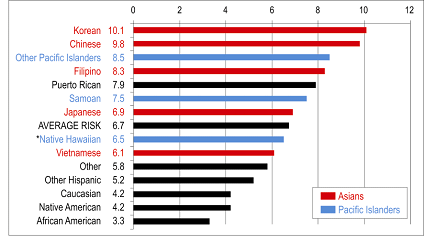Kaiser Permanente study first to measure gestational diabetes risk among 14 ethnic groups in Hawaii
December 11 2009 (Portland, Ore.) – More than 10 percent of women of Korean and Chinese heritage may be at risk for developing diabetes during pregnancy, according to a Kaiser Permanente study of 16,000 women in Hawaii that appears in the current issue of the Ethnicity and Disease journal. The study also found that Korean-American and Chinese-American women’s gestational diabetes risk is one-third higher than average—and more than double that of Caucasian and African-American women.
Funded by the American Diabetes Association, the study found that Pacific Islanders, Filipinos, Puerto Ricans, and Samoans are also at higher-than-average risk—while Caucasian, Native-American, and African-American women have a lower-than-average risk.
Untreated gestational diabetes mellitus can lead to serious pregnancy and birthing complications, including early delivery and C-sections. It can also increase the child’s risk of developing obesity later in life.
While previous studies have shown that GDM is more prevalent among Asian women and Pacific Islanders, this is the first study to separate those ethnic groups into sub-categories to find out who is at higher risk. Researchers chose Hawaii for the study because it has one of the most ethnically diverse populations in the world.
Researchers divided Asians into five ethnic sub-groups and found some striking differences: Korean and Chinese women have the greatest risk of developing GDM. Filipinos are next, but Japanese and Vietnamese women have the same risk as the rest of the population. Among three groups of Pacific Islanders, Samoans and Other Pacific Islanders (including women from Fiji and Tahiti) have a higher-than-average risk, while women classified as Native Hawaiians are at average risk.* Caucasian, Native-American, and African-American women have the lowest risk for developing GDM.

*If a woman reports having any Native Hawaiian background the state health department classifies her as full Native Hawaiian, so there are likely women in this group with mixed ethnicity and very little Native Hawaiian heritage. The authors believe women who are full Native Hawaiian may have a higher risk than what is reported in the paper.
“This study has important implications for diagnosis and treatment of gestational diabetes,” said study lead author Kathryn Pedula, MS, a researcher at the Kaiser Permanente Center for Health Research. “All pregnant women and their caregivers need to be educated about gestational diabetes, but it is especially important for women in these ethnic groups at higher risk.”
“Many previous studies have lumped all Asians and Pacific Islanders together---we now know that the risk for developing GDM varies greatly depending on your specific ethnic background,” said study co-author Teresa Hillier, MD, MS, a senior investigator at the Kaiser Permanente Center for Health Research. “Future studies should also look at whether women in these higher risk groups also have more complications.”
This study involved 16,757 women aged 13-39, who gave birth in the Kaiser Permanente Health Plan in Hawaii between 1995 and 2003. Some women had more than one child during that time, bringing the total number of pregnancies to 22,110. Researchers obtained ethnic classification from the mothers’ birth certificates on file with the Hawaii Department of Health.
All women in the Kaiser Permanente system are screened for gestational diabetes between 24-28 weeks of pregnancy. If they have GDM, they are treated as part of routine care. More than 20 percent of women in the study had elevated glucose levels, and 6.7 percent of women met the Carpenter and Coustan threshold for gestational diabetes.
"This study underscores Kaiser Permanente's commitment to identify differences in risk and clinical outcomes for different ethnic and racial groups,” said Winston F. Wong, MD, MS, medical director of Kaiser Permanente’s Community Benefit Disparities Improvement and Quality Initiatives. “While we cannot eliminate the increased risk of prenatal diabetes among our Korean and Chinese patients, we use this kind of research to alert and empower our health care professionals and physicians to reduce disparities and achieve the best possible outcomes for our patients and their children."
Study authors include Kathryn L. Pedula, MS, and Teresa A. Hillier, MD, MS, from the Kaiser Permanente Center for Health Research in Portland, Ore.; Mark M. Schmidt, BA, Kaiser Permanente Center for Health Research, Honolulu; Judith A. Mullen, APRN, BC,CDE, Kaiser Permanente, Honolulu, Hawaii; Marie-Aline Charles, MD, MPH, INSERM, Paris, France; and David J. Pettitt, MD, Sansum Diabetes Research Institute, Santa Barbara, Calif.
Kaiser Permanente is America’s leading integrated health care organization. Founded in 1945, the organization serves the health needs of more than 8.7 million people nationwide. Nearly 480,000 people in Oregon and Southwest Washington receive their health care from Kaiser Permanente. www.kaiserpermanente.org.